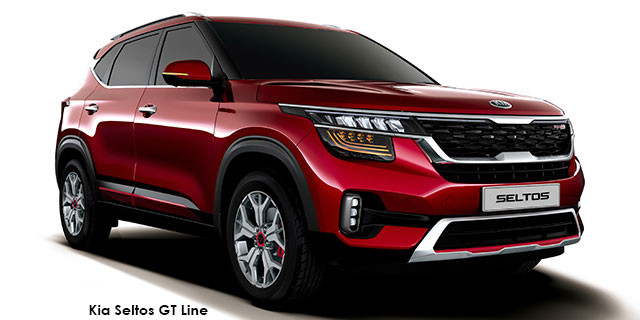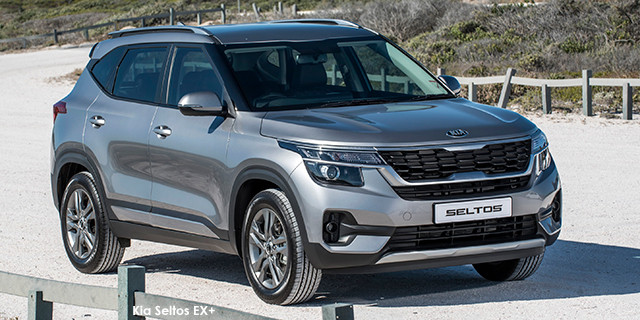
Sporting a naturally aspirated engine, this Kia Seltos is the more conservative option against the 1,4 turbo...
As European carmakers persist with forced-induction on the eve of widespread electrification, manufacturers such as Kia are still putting the naturally aspirated engine to good use. This is something we see in the Seltos range: a turbocharged powertrain in its flagship while a simpler naturally aspirated mill is placed throughout the lower end of the line-up, as seen in this EX+ trim.
This derivative sits directly beneath the GT-Line we've already tested (also featuring in our long-term test fleet) with a slightly less generous list of standard features at R55 000 less. The EX+ does without keyless entry, LED head- , fog- and taillamps, alloy pedals, drive mode selector and a fast-charging USB port in the centre console. It ships standard, however, with an armrest, electro-chromatically dimmed rear-view mirror, auto-on lights and an eight-inch touchscreen infotainment system connected to six speakers. Essential safety features include six airbags, electronic stability control, hill-start assist and rear parking assist with a camera.
Visually, EX+ trim is more conservative and does away with the chrome details from the GT-Line; a design choice we declared a hit and miss. A set of five-spoke 17-inch alloy wheels sans the red detailing and brake callipers maintains its conservatively classy image. The front has a simpler grille design but retains the silver surrounds flowing into the headlamps.
The cabin boasts luxurious elements such as artificial leather upholstery for the seats, steering wheel and gear selector. The dashboard is modern but the use of hard plastic along it and the centre console’s width detracts from the perceived quality. The abstract design of the speakers and the mood lighting add ambience and character.
As mentioned, things are more traditional under the bonnet where Kia’s 1,6-litre four-cylinder multipoint injection Gamma engine delivers 90 kW and 151 N.m of torque to the front wheels through a six-speed torque-converter. As per CAR’s fuel index, the EX+ delivers a heavier consumption figure of 8,64 L/100 km compared to the TGDI unit’s 7,60 L/100 km. On our fuel route, the Seltos returned a more impressive 6,9 L/100 km; just 0,3 L/100 km above the GT-Line’s result.
Although we may have been able to improve the fuel consumption over Kia’s claim, the same cannot be said for the EX+’s performance. Our best 0-100 km/h sprint time of 12,65 seconds is 1,45 seconds slower than claimed. In-gear acceleration at lower speeds is acceptable but the vehicle runs out of steam at higher velocities; overtaking slower vehicles in a fully loaded Seltos takes some careful planning.
While the engine’s performance is middling, the transmission does it few favours. Indecisiveness at lower speeds does make way for more settled cruising once at the national limit. At least the shifts are impeccably smooth.
Sitting on a rear multilink suspension, the Seltos offers a dynamic driving experience that’s complemented by a well-weighted electrically assisted power steering but, despite fairly thick profiled tyres, the ride is quite firm (although it just stops short of feeling crashy).
Using the same tyres and brakes as the GT-Line, the Seltos achieved a similar average 100-0 km/h stopping time of 2,94 seconds. Upon hard braking, it retained composure without deviating to the side but quite a bit of forward lean was noted.
Where refinement is concerned, the EX+’s drivetrain is not on par with the Germans as the engine is quite audible from the cabin. At motorway speeds, road noise is prevalent which further detracts from the crossover’s otherwise commendable NVH levels, including the 41 dBA cabin noise level at idle.
TEST SUMMARY
On paper, EX+ trim makes the Seltos a better value-for-money proposition than the flagship by providing a plethora of standard safety and convenience features at a decent saving. It mixes a welcome modern and trendy design with an appealingly grown-up persona through the omission of chrome detailing. The crossover excels in terms of packaging and dynamics, too, but the powertrain and transmission do dent its appeal somewhat.
A forced-induction crossover such as the Volkswagen T-Cross 1,0 TSI Highline offers improved performance and refinement but smaller packaging. Although the EX+ spec is generous, the GT-Line remains the sweet spot of the range (until we get to sample the turbodiesel variants) thanks to its more capable and efficient drive-train. However, if it’s style and packaging with a more traditional drivetrain you’re after (and a Sportage is too big for your needs), the EX+ is a sound option.
ROAD TEST SCORE

|

|

|
Original article from Car
See Full Kia Seltos price and specs here









